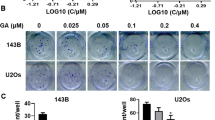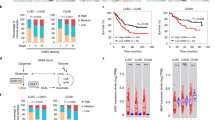Abstract
Aim:
Gambogic acid (GA) is the major active ingredient of gamboge, which is secreted from a Chinese traditional medicine, Garcinia hanburyi, which possesses potent antitumor activity. GA3, a new GA derivative, has been shown to possess better water solubility than GA. The aim of the present study was to examine the antitumor activity of GA3 and the mechanism underlying it.
Methods:
The growth inhibition of cancer cell lines induced by GA3 was assessed using the SRB assay. DAPI staining, flow cytometry, a DNA fragment assay, and Western blot analysis were used to study the apoptotic mechanisms of GA3.
Results:
GA3 displayed wide cytotoxicity in diversified human cancer cell lines with a mean IC50 value of 2.15 μmol/L. GA3 was also effective against multidrug resistant cells, with an average resistance factor (RF) that was much lower than that of the reference drug, doxorubicin. Mechanistic studies revealed that GA3-induced apoptosis in HL-60 cells proceeded via both extrinsic and intrinsic pathways, with caspase-8 functioning upstream of caspase-9. In addition, GA3-driven apoptotic events were associated with up-regulation of Bax, down-regulation of Bcl-2 and cleavage of Bid. Moreover, GA3 triggered cytochrome c release from the mitochondria, in particular bypassing the involvement of the mitochondrial membrane potential.
Conclusion:
Better solubility and a potential anti-MDR activity, combined with a comparable antitumor efficacy, make GA3 a potential drug candidate in cancer therapy that deserves further investigation.
Similar content being viewed by others
Log in or create a free account to read this content
Gain free access to this article, as well as selected content from this journal and more on nature.com
or
References
Guo QL, You QD, Wu ZQ, Yuan ST, Zhao L . General gambogic acids inhibited growth of human hepatoma smmc-7721 cells in vitro and in nude mice. Acta Pharmacol Sin 2004; 25: 769–74.
Liu W, Guo QL, You QD, Zhao L, Gu HY, Yuan ST . Anticancer effect and apoptosis induction of gambogic acid in human gastric cancer line bgc-823. World J Gastroenterol 2005; 11: 3655–9.
Zhao L, Guo QL, You QD, Wu ZQ, Gu HY . Gambogic acid induces apoptosis and regulates expressions of bax and bcl-2 protein in human gastric carcinoma mgc-803 cells. Biol Pharm Bull 2004; 27: 998–1003.
Pandey MK, Sung B, Ahn KS, Kunnumakkara AB, Chaturvedi MM, Aggarwal BB . Gambogic acid, a novel ligand for transferrin receptor, potentiates tnf-induced apoptosis through modulation of the nuclear factor-{kappa}b signaling pathway. Blood 2007; 110: 3517–25.
Qin Y, Meng L, Hu C, Duan W, Zuo Z, Lin L, et al. Gambogic acid inhibits the catalytic activity of human topoisomerase IIalpha by binding to its atpase domain. Mol Cancer Ther 2007; 6: 2429–40.
Han QB, Cheung S, Tai J, Qiao CF, Song JZ, Xu HX . Stability and cytotoxicity of gambogic acid and its derivative, gambogoic acid. Biol Pharm Bull 2005; 28: 2335–7.
Skehan P, Storeng R, Scudiero D, Monks A, McMahon J, Vistica D, et al. New colorimetric cytotoxicity assay for anticancer-drug screening. J Natl Cancer Inst 1990; 82: 1107–12.
Hotz MA, Gong J, Traganos F, Darzynkiewicz Z . Flow cytometric detection of apoptosis: comparison of the assays of in situ DNA degradation and chromatin changes. Cytometry 1994; 15: 237–44.
Steinfelder HJ, Quentin I, Ritz V . A fast and sensitive technique to study the kinetics and the concentration dependencies of DNA fragmentation during drug-induced apoptosis. J Pharmacol Toxicol Methods 2000; 43: 79–84.
Lu JJ, Meng LH, Cai YJ, Chen Q, Tong LJ, Lin LP, et al. Dihydroartemisinin induces apoptosis in hl-60 leukemia cells dependent of iron and p38 mitogen-activated protein kinase activation but independent of reactive oxygen species. Cancer Biol Ther 2008; 7: 1017–23.
Steller H . Mechanisms and genes of cellular suicide. Science 1995; 267: 1445–9.
Fesik SW . Promoting apoptosis as a strategy for cancer drug discovery. Nat Rev Cancer 2005; 5: 876–85.
Reed JC . Apoptosis-regulating proteins as targets for drug discovery. Trends Mol Med 2001; 7: 314–9.
Riedl SJ, Shi Y . Molecular mechanisms of caspase regulation during apoptosis. Nat Rev Mol Cell Biol 2004; 5: 897–907.
Borner C, Monney L . Apoptosis without caspases: an inefficient molecular guillotine? Cell Death Differ 1999; 6: 497–507.
Hengartner MO . The biochemistry of apoptosis. Nature 2000; 407: 770–6.
Kim KS . Multifunctional role of fas-associated death domain protein in apoptosis. J Biochem Mol Biol 2002; 35: 1–6.
Green DR, Reed JC . Mitochondria and apoptosis. Science 1998; 281: 1309–12.
Gross A, Jockel J, Wei MC, Korsmeyer SJ . Enforced dimerization of bax results in its translocation, mitochondrial dysfunction and apoptosis. Embo J 1998; 17: 3878–85.
Oltvai ZN, Milliman CL, Korsmeyer SJ . Bcl-2 heterodimerizes in vivo with a conserved homolog, bax, that accelerates programmed cell death. Cell 1993; 74: 609–19.
Gincel D, Zaid H, Shoshan-Barmatz V . Calcium binding and translocation by the voltage-dependent anion channel: a possible regulatory mechanism in mitochondrial function. Biochem J 2001; 358 (Pt 1): 147–55.
Kim TH, Zhao Y, Barber MJ, Kuharsky DK, Yin XM . Bid-induced cytochrome c release is mediated by a pathway independent of mitochondrial permeability transition pore and bax. J Biol Chem 2000; 275: 39474–81.
Yin XM, Wang K, Gross A, Zhao Y, Zinkel S, Klocke B, et al. Bid-deficient mice are resistant to fas-induced hepatocellular apoptosis. Nature 1999; 400: 886–91.
Yu J, Guo QL, You QD, Zhao L, Gu HY, Yang Y, et al. Gambogic acid-induced G2/m phase cell-cycle arrest via disturbing cdk7-mediated phosphorylation of cdc2/p34 in human gastric carcinoma bgc-823 cells. Carcinogenesis 2007; 28: 632–8.
Acknowledgements
This work was financially supported by the National Natural Science Foundation of China (No 30721005). Hua XIE especially appreciated the support from a Shanghai Postdoctoral Grant (No 05R214157).
Author information
Authors and Affiliations
Corresponding authors
Rights and permissions
About this article
Cite this article
Xie, H., Qin, Yx., Zhou, Yl. et al. GA3, a new gambogic acid derivative, exhibits potent antitumor activities in vitro via apoptosis-involved mechanisms. Acta Pharmacol Sin 30, 346–354 (2009). https://doi.org/10.1038/aps.2009.3
Received:
Accepted:
Published:
Issue date:
DOI: https://doi.org/10.1038/aps.2009.3
Keywords
This article is cited by
-
Ameliorative effects of Dictyota dichotoma on hepatotoxicity induced by gibberellic acid in albino rats
Toxicological Research (2022)
-
Molecular targets of gambogic acid in cancer: recent trends and advancements
Tumor Biology (2016)
-
New targets for the antitumor activity of gambogic acid in hematologic malignancies
Acta Pharmacologica Sinica (2013)
-
Establishment of platform for screening insulin-like growth factor-1 receptor inhibitors and evaluation of novel inhibitors
Acta Pharmacologica Sinica (2011)
-
Jolkinolide B from Euphorbia fischeriana Steud induces apoptosis in human leukemic U937 cells through PI3K/Akt and XIAP pathways
Molecules and Cells (2011)



